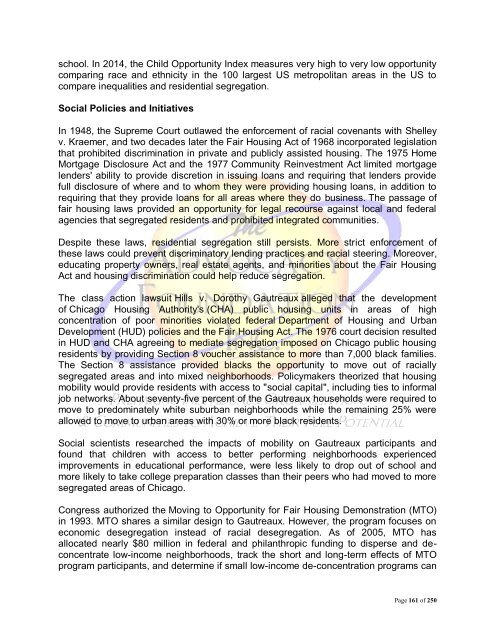Institutional Racism
Institutional Racism
Institutional Racism
You also want an ePaper? Increase the reach of your titles
YUMPU automatically turns print PDFs into web optimized ePapers that Google loves.
school. In 2014, the Child Opportunity Index measures very high to very low opportunity<br />
comparing race and ethnicity in the 100 largest US metropolitan areas in the US to<br />
compare inequalities and residential segregation.<br />
Social Policies and Initiatives<br />
In 1948, the Supreme Court outlawed the enforcement of racial covenants with Shelley<br />
v. Kraemer, and two decades later the Fair Housing Act of 1968 incorporated legislation<br />
that prohibited discrimination in private and publicly assisted housing. The 1975 Home<br />
Mortgage Disclosure Act and the 1977 Community Reinvestment Act limited mortgage<br />
lenders' ability to provide discretion in issuing loans and requiring that lenders provide<br />
full disclosure of where and to whom they were providing housing loans, in addition to<br />
requiring that they provide loans for all areas where they do business. The passage of<br />
fair housing laws provided an opportunity for legal recourse against local and federal<br />
agencies that segregated residents and prohibited integrated communities.<br />
Despite these laws, residential segregation still persists. More strict enforcement of<br />
these laws could prevent discriminatory lending practices and racial steering. Moreover,<br />
educating property owners, real estate agents, and minorities about the Fair Housing<br />
Act and housing discrimination could help reduce segregation.<br />
The class action lawsuit Hills v. Dorothy Gautreaux alleged that the development<br />
of Chicago Housing Authority's (CHA) public housing units in areas of high<br />
concentration of poor minorities violated federal Department of Housing and Urban<br />
Development (HUD) policies and the Fair Housing Act. The 1976 court decision resulted<br />
in HUD and CHA agreeing to mediate segregation imposed on Chicago public housing<br />
residents by providing Section 8 voucher assistance to more than 7,000 black families.<br />
The Section 8 assistance provided blacks the opportunity to move out of racially<br />
segregated areas and into mixed neighborhoods. Policymakers theorized that housing<br />
mobility would provide residents with access to "social capital", including ties to informal<br />
job networks. About seventy-five percent of the Gautreaux households were required to<br />
move to predominately white suburban neighborhoods while the remaining 25% were<br />
allowed to move to urban areas with 30% or more black residents.<br />
Social scientists researched the impacts of mobility on Gautreaux participants and<br />
found that children with access to better performing neighborhoods experienced<br />
improvements in educational performance, were less likely to drop out of school and<br />
more likely to take college preparation classes than their peers who had moved to more<br />
segregated areas of Chicago.<br />
Congress authorized the Moving to Opportunity for Fair Housing Demonstration (MTO)<br />
in 1993. MTO shares a similar design to Gautreaux. However, the program focuses on<br />
economic desegregation instead of racial desegregation. As of 2005, MTO has<br />
allocated nearly $80 million in federal and philanthropic funding to disperse and deconcentrate<br />
low-income neighborhoods, track the short and long-term effects of MTO<br />
program participants, and determine if small low-income de-concentration programs can<br />
Page 161 of 250

















